Brazilian Portuguese Food Vocabulary to Satiate Your Hunger
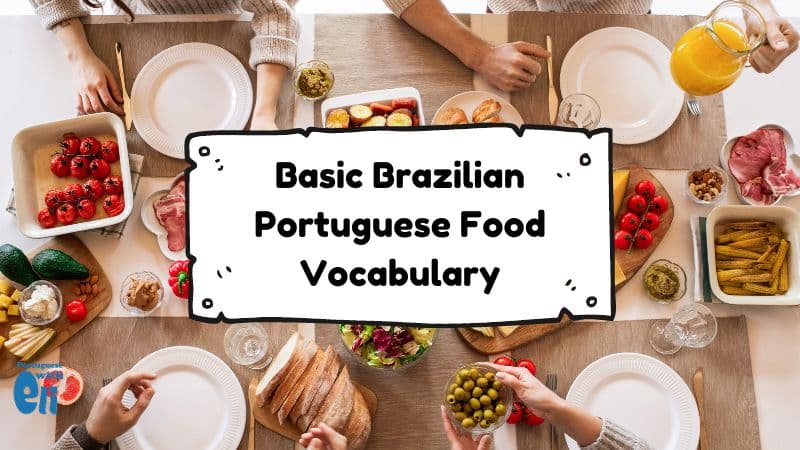
I’m not sure about you, but one of the main things I want to learn in all languages is how to talk about food. And if you need Brazilian Portuguese food vocabulary because you’re joining Brazilians in a churrasco or traveling in Rio de Janeiro alone, I can help you now.
In this blog post, I will provide a list of common Brazilian Portuguese food vocabulary and some useful phrases you can use when eating out in Brazil.
We’ll go meal by meal: like I usually say to my students, let’s do like Jack and go part by part.
Breakfast in Brazilian Portuguese – Important Notes
Breakfast is an important meal of the day in Brazil. The traditional Brazilian breakfast is called “café da manhã.”
A common café da manhã is composed of the following:
- O pão, a manteiga ou a margarina e o café preto. Bread, butter or margarine, and black coffee.
Depending on how you like your coffee, you might have it:
- Café preto. Black coffee.
- Café com leite. Coffee and milk.
- Média. Half coffee, half milk.
A more elaborate breakfast in Brazil will have fruta (fruit), suco (juice), and sometimes bolo (cake) or other local pastry.
When it comes to fruit, some people will have it all day long. The kind of fruit varies from region to region and from season to season.
If a particular kind of fruit is “fruta da estação” (fruit of the current season), it’s cheaper. In general, you can find different types of fruit all year round.
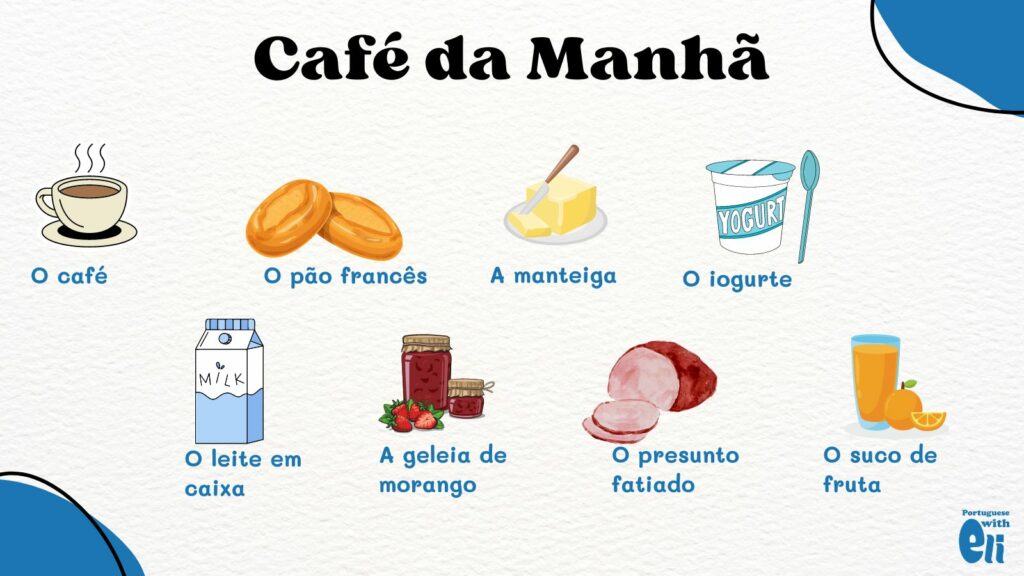
Cultural Note:
Depending on where you are, you will hear people used to expressions to say “to have breakfast”:
- Merendar
- Tomar café da manhã
Both are valid, but the first word also means “to have a snack at any time.”
I usually say “merendar” — that’s the current word in using my home state, Ceará.
A Few Useful Phrases to Talk About Breakfast in Brazilian Portuguese
Eu gostaria de um café com leite, por favor. I would like a coffee with milk, please.
Você tem pão de queijo? Do you have cheese bread?
Pode me dar um pedaço de fruta? Can you give me a piece of fruit?
Lunchtime — Vocabulary and Notes You’ll Want to Have
Lunch is the main meal of the day in Brazil. It is usually served between noon and 2 pm. The traditional Brazilian lunch, called “almoço,” typically consists of rice, beans, meat, and salad.
Rice and beans are an essential part of Brazilian cuisine and hold great significance in the country’s food culture. In fact, rice and beans are considered the staple food of Brazil and are a part of almost every meal. And I mean it.
Once, a friend from Budapest stayed at my family’s house. On the first day, she was happy to eat rice and beans. On the second day, she was surprised that it was rice and beans. On the third day, she didn’t want to eat rice and beans anymore, but that is all we had, so she had to make do with it.
And rice and beans are so fundamental to our diet that we even included that in our dialogue to refer to the basics of something.
- Isso que você aprendeu é só o feijão com arroz do nosso trabalho. Ainda tem muito que aprender. What you have learned is just the basic stuff of our work. You still have a lot to learn.
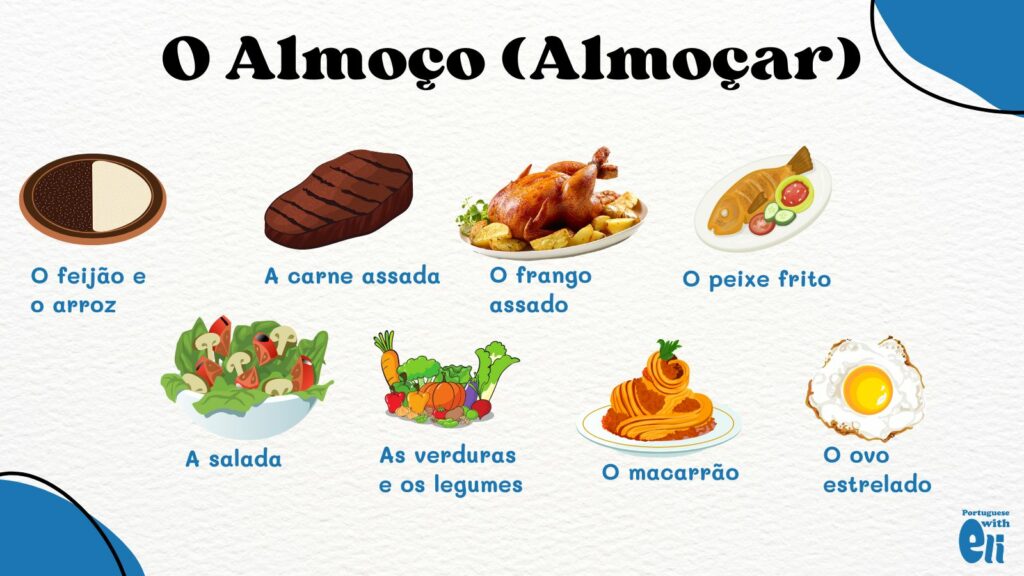
How about Dinner in Brazilian Portuguese?
Dinner is usually a lighter meal than lunch in Brazil, and people typically have dinner between 6:30 pm and 9 pm. The traditional Brazilian dinner is called “o jantar” (looks like the verb) and can consist of various dishes, including soup, pasta, and fish.
But in my experience, the most common thing is to have whatever is left over from lunch for dinner.
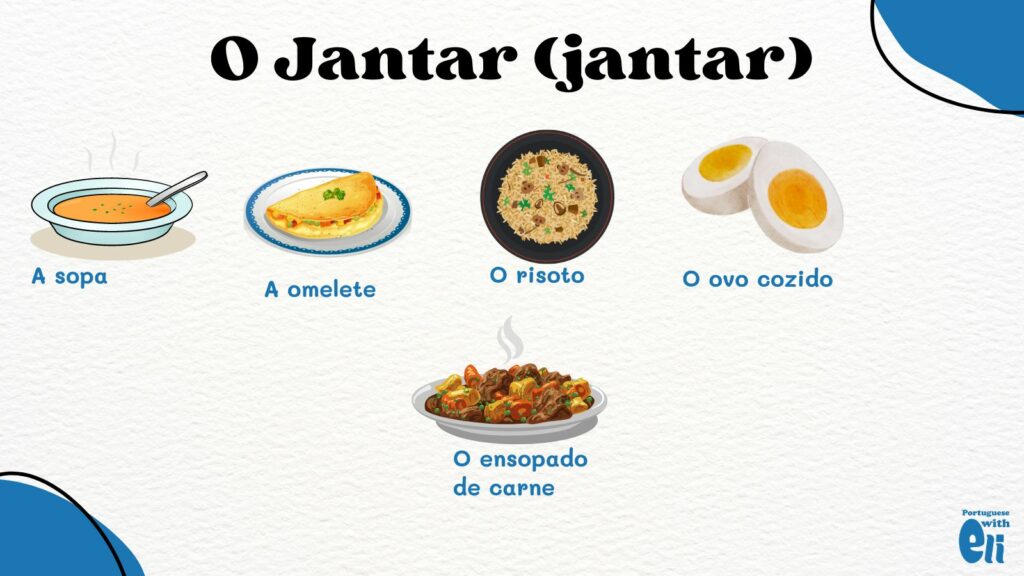
After a Main Meal: Desserts
Desserts (“sobremesas”) are an essential part of Brazilian cuisine and come in many different forms, from cakes and pastries to ice cream and fruit.
The most common ones in my experience have always been fruit, especially banana, apples mandarines, and frutas da estação.
Anything more elaborate than that tends to be reserved for special occasion.
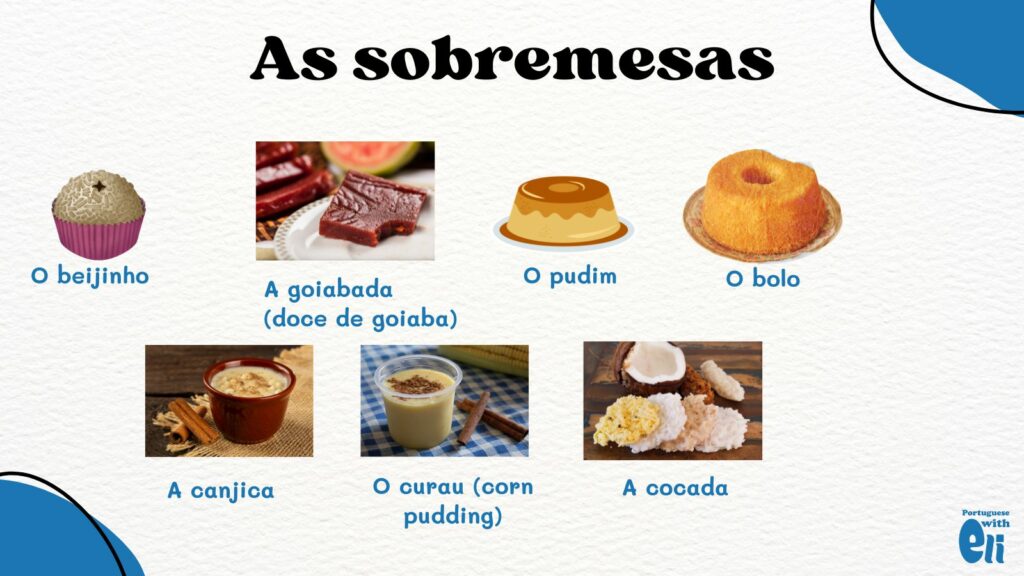
Closing Thoughts and Encouragement
This small list isn’t exhaustive, as you’ve seen. I want to give you just the arroz e feijão while adding a bit more of cultural understanding to your repertoire.
Don’t try to learn Brazilian Portuguese food vocabulary out of context. I am including separate words here, but you should pick and choose those that are more relevant to your situation.
When the opportunity arises, use the word.
By using the vocabulary and phrases provided in this blog post, you can order food confidently and understand when people talk about it.
Are there any vocabulary fields you would like to see in our blogs? Let me know in the comments below 🙂
And because no word can be learned in a vacuum, I suggest you grab the Portuguese Learner Starter Kit, which will give you the tools to use these words properly.



